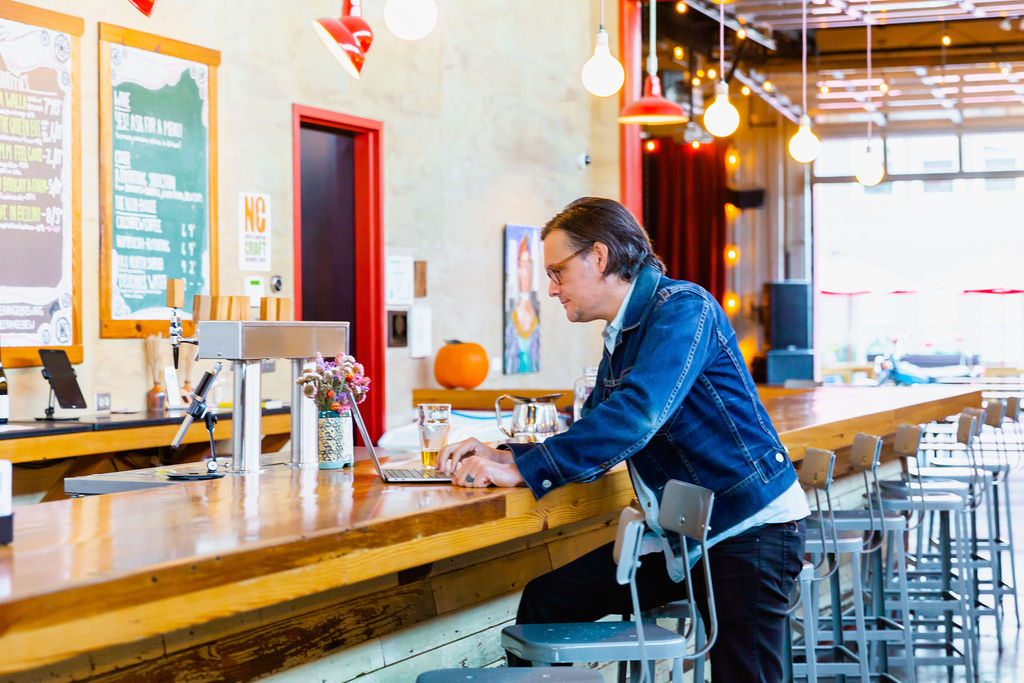5 Essential KPIs for Taproom Managers
Below you’ll find the 5 essential KPIs for taproom managers that can help you see greater success.

Taproom managers wear many hats that correspond to a countless number of responsibilities. From hiring to firing, to training and retaining, it is the goal of taproom managers to equally maximize the experience of their guests as it is their staff. One of their most valuable tools to create a successful taproom is data. By understanding data, taproom managers can monitor, maximize, and maintain world-class experiences that customers crave and their team is proud to be a part of, leading to more memorable and profitable taprooms.
Here are 5 essential KPIs for taproom managers that can help you see greater success.
But first, what’s a KPI?
KPIs, or Key Performance Indicators, are the most important numbers to measure in your business. Think of KPIs like the gauges on the dashboard of your car. The speedometer measures how fast you’re driving, the fuel gauge shows how much is in the tank, and the check engine light tells you if you’re overdue for maintenance. Those are important things to know to keep your car running smoothly and legally. Likewise, KPIs for your taproom business need to track the same critically important measurements.
#1: Tip Percentage
What it is: Tip percentage is the tip amount divided by the total tab (i.e. a $10 tip on a $40 tab equals 25%).
Why it’s important: Tip percentage corresponds directly to staff member engagement with guests. From Secret Hopper data, we see that when staff offer a low level of engagement, the average tip percentage is 23%. When staff offer a high level of engagement, the average tip percentage is 27%. If Andrew’s average tip percentage is 17% and Kary’s is 27%, it can be deduced that Kary is going above and beyond to build relationships with his guests.
Where to find this data: Your POS system. If your employees have their own login, it’ll be easy to see their individual tip percentages. If your setup has your team sharing a login, monitor trends over time. For example, if you typically have 3 taproom servers in the taproom and when Andrew’s behind the bar you see a lower average tip percentage, you’ll be able to discover that he’s the weak link.
How you can use it: Reward and recognize team members who consistently receive a high tip percentage. Make them feel appreciated. When you discover a team member who receives a lower than average tip percentage, use this as a training opportunity. Speak to this employee and discuss what can be done to offer greater support. Even for employees that may treat their position as “just a job,” money can be a motivator. The more employees take the time to build relationships with taproom guests, the higher their tip will be, making them a little bit more money and a little bit happier. As a manager, having happier and better compensated staff will make your life easier.
#2: To-Go Sales
What it is: To-go sales represent additional purchases on a tab for consumption outside the brewery. Think crowlers, growlers, bottles, and cans.
Why it’s important: Encouraging beer to-go is an actionable strategy you can train your team to authentically implement that generates immediate returns. On taproom visits when staff do not suggest beer to-go, the guest only makes the purchase 9% of the time on their own. When taproom staff encourage the guest to take beer to-go, the guest makes the added purchase 49% of the time, resulting in tabs nearly $15 higher.
This metric is not only important as a tool to motivate taproom staff to increase their tabs, but also a valuable KPI for managers/owners to monitor and reward your team.
Where to find this data: Your POS! Ask your provider the easiest way to filter transactions that include to-go purchases. Consult this data regularly and see who on your team is demonstrating upsell skills.
How you can use it: Engagement is a common thread in these top 2 KPIs, and you are likely to see those with the highest tip percentages also selling the most to-go beer. Makes sense, right? Your most engaged team members are developing deep relationships with your guests, and are more likely to also suggest taking beer home. Hold frequent to-go beer competitions to see who can sell the most over X period of time, whether a Saturday afternoon, an entire month, or based on hours worked. Moreover, don’t just consistently reward the same top sellers. Consider using this to-go data to recognize your most improved staff on suggesting beer to-go. Whether we’re talking about brand new employees or 10-year taproom veterans, regularly monitor this KPI to make sure they’re using it to their advantage. After all, what server doesn’t want to get tipped a little more when their tab also includes beer to-go? As a taproom manager, monitoring this KPI will help you better maximize the amount of to-go beer sales and increase overall in-house revenue.
#3: Number of Customers
What it is: The number of customers represents what you might expect – the foot traffic into your taproom. This is how many people come in during a given day, week, month, or year.
Why it’s important: Clearly, the more people who come in, the more sales you can generate. We often create taproom sales projections using just two numbers to start: 1) Customers x 2) Average Spend Per Customer (which we’ll cover next).
These two data points are the key drivers of revenue through your taproom. The more you can increase one or both of these KPIs the more you can boost your taproom sales.
Where to find this data: Here again, your point of sale system will track this data. It may be useful to create your own trackers (hello, spreadsheets!) so that you can easily access historical information and make use of week over week and month over month comparisons.
How you can use it: Set up a simple spreadsheet to track the total number of customer visits by week and by month. Pull information from the prior year (or years) so that you can see what the trends look like. Are the number of customers increasing or decreasing month over month? Are there patterns that emerge when you look at the historical data? Are there weeks or months that have unusually high volumes of customers? Why did that happen? Can you duplicate this, or do more of the things that brought people in?
The goal of tracking the number of customers is simple: bring more customers in to spend more money so that you can increase sales. However, tracking the numbers isn’t enough. Review the trends and use the data to brainstorm ways to increase traffic.
#4: Average Spend per Customer
What it is: The average spend per customer is a measurement of (you guessed it) how much folks spend when they come into your taproom. You may see this KPI also shown as average spend per check. Whichever measurement you use, this is an important one to track so that you can understand spending patterns, habits and identify ways to improve on each.
Why it’s important: When customers come into your taproom they want to buy from you. Unlike some retail stores, where people go in to browse and just look around, folks are coming into your taproom to buy. They want a beer, some food, and maybe some merchandise. The more you have to offer, and the easier it is to buy it, the more your customers will spend. And the more they spend, the more financially viable and successful your business will be.
Where to find this data: We’re starting to sound like a broken record here, but your point of sale system is the place where you’ll find average spend per customer (or check) data.
How you can use it: The old saying goes that your best customer is the customer you already have. These are the people that have already purchased from you and love what you have to offer. Why not work to offer them more when they come to your taproom?
As with most KPIs, it is useful to take the measurements over time, analyze the trends, and make comparisons. A key best practice is to benchmark against your past performance and work to improve the number.
#5: Revenue per Barrel (BBL)
What it is: Revenue per barrel, or sales per barrel, is a measurement of how effectively you are monetizing a barrel of beer.
To do the calculation, take the total number of dollars sold through the taproom in a given time period and divide by the total number of barrels transferred to the taproom.
For example, in the month of January taproom sales were $100,000, and there were 100 barrels of beer transferred and depleted during January. $100,000 divided by 100 barrels = $1,000 per barrel.
Why it’s important: The revenue per barrel KPI shows how many dollars each barrel of beer is making us, and will provide clues as to how we can make more.
Furthermore, one of the key tenets of business and financial management is the safeguarding of assets. The revenue per barrel KPI can help with this.
What this means is that we need to have checks and balances to make sure that our assets are well taken care of and that we are getting a proper return on our investments. The revenue per barrel KPI can help identify beer loss when the number dips below expectations.
To continue the example above, let’s say you’ve been measuring revenue per barrel for years and it tends to be around $1,000 per barrel. Fairly common. Then one month it dips to $800 per barrel and stays at this level for several months. What happened? The KPI won’t answer this question, but it will force you to go and figure it out.
Where to find this data: Again, for this KPI you’ll need to know total taproom sales in a given period and total barrels transferred to the taproom. The POS will have the sales data and your production software (or accounting software) will have the total barrels transferred.
How you can use it: As with the KPIs discussed above, set up a tracking system to show month over month revenue per barrel numbers. Look back for 12-24 months and see what the trends look like. Is the KPI increasing? Decreasing? Staying about the same? You can use this data to inform pricing decisions, product mix, and pour sizes.
Understanding KPIs provides you the ability to find out where your taproom stands, spot areas of opportunity, and the tools to monitor consistency and quality. Moreover, don’t just treat the data as numbers, use it to reward and recognize your team for a job well done. As a taproom manager, these KPIs are vital assets in your toolkit to see greater taproom success.
ABOUT THE AUTHORS:

Andrew Coplon is the Founder of Secret Hopper and Craft Beer Professionals. Andrew helps breweries nationwide create more memorable and profitable taproom experiences using data-based insights gathered from thousands of visits. He has successfully built a community of 16,000 Craft Beer Professionals dedicated to the growth and betterment of our industry across the United States. When he isn’t building relationships on Zoom or meeting you for a pint, he enjoys climbing jungle gyms with his son, Max, or planning the next adventure with his wife, Stacie.

Kary Shumway is the founder of Craft Brewery Financial Training.com, an online resource for beer industry professionals. He has worked in the beer industry for more than 20 years as a certified public accountant and a chief financial officer for a beer distributor. He currently serves as CFO for Wormtown Brewery in Worcester, Massachusetts. Craft Brewery Financial Training publishes a weekly beer industry finance newsletter, offers online training courses on topics such as cash flow planning, financial forecasting, and brewery metrics. For more information visit www.CraftBreweryFinancialTraining.com.
Andrew and Kary have combined their forces as the Taproom Success Membership. Taproom Success gives you the tools, resources, and support you need to manage and grow your taproom business. From fundamentals, to best practices, backed by data, and actionable strategies, the Taproom Success Membership fills the void of taproom educational opportunities.
